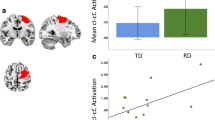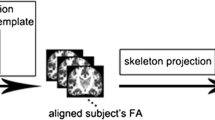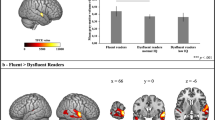Abstract
Narrative comprehension is a linguistic ability that is foundational for future reading ability. The aim of the current study was to examine the neural circuitry of children with reading difficulties (RD) compared to typical readers during a narrative-comprehension task. We hypothesized that due to deficient executive functions, which support narrative comprehension abilities, children with RD would display altered activation and functional connectivity, as well as lower performance on a narrative-comprehension task. Children with RD and typical readers were scanned during a narrative-comprehension task and administered reading behavioral tests. Children with RD scored significantly lower on the narrative-comprehension task than did typical readers. Composite activation maps showed more diffused activation during narrative comprehension in the RD group. Maps comparing the two reading groups showed more activation in the frontal lobes (regions responsible for executive functions), and functional connectivity showed higher global efficiency in children with RD than in typical readers. Global efficiency was negatively correlated with phonological awareness and reading and executive function scores in the entire study group. Children with RD may suffer from narrative-comprehension difficulties due to diffused activation of language areas, as was observed during a narrative-comprehension task. Greater effort in this task may be reflected by the engagement of brain regions related to executive functions and higher functional connectivity or attributed to difficulties in phonological processing and reading and executive functions. Therefore, the accommodation given to children with RD of reading aloud may need to be revised due to the observed difficulty in this domain.






Similar content being viewed by others
References
Altaye, M., Holland, S. K., Wilke, M., & Gaser, C. (2008). Infant brain probability templates for MRI segmentation and normalization. NeuroImage, 43(4), 721–730.
Baria, A. T., Baliki, M. N., Parrish, T., & Apkarian, A. V. (2011). Anatomical and functional assemblies of brain BOLD oscillations. The Journal of Neuroscience, 31(21), 7910–7919.
Berl, M. M., Duke, E. S., Mayo, J., Rosenberger, L. R., Moore, E. N., Van Meter, J., et al. (2010). Functional anatomy of listening and reading comprehension during development. Brain and Language, 114(2), 115–125.
Bishop, D. V., & Adams, C. (1990). A prospective study of the relationship between specific language impairment, phonological disorders and reading retardation. Journal of Child Psychology and Psychiatry, 31(7), 1027–1050.
Brown, L., Sherbenou, R., & Johnsen, S. (1997). Test of nonverbal intelligence (3rd ed.). Austin: Pro-Ed.
Byars, A. W., Holland, S. K., Strawsburg, R. H., Bommer, W., Dunn, R. S., Schmithorst, V. J., et al. (2002). Practical aspects of conducting large-scale functional magnetic resonance imaging studies in children. Journal of Child Neurology, 17(12), 885–890.
Cain, K. (2015). The interdependent roles of oral language and reading comprehension. Routledge Handbook of Communication Disorders. 204.
Conners, C. K. (1989). Conners rating scales’ manual. North Towonada: Multihealth System.
Dehaene-Lambertz, G., Dehaene, S., & Hertz-Pannier, L. (2002). Functional neuroimaging of speech perception in infants. Science, 298(5600), 2013–2015.
Dehaene-Lambertz, G., Hertz-Pannier, L., Dubois, J., Mériaux, S., Roche, A., Sigman, M., et al. (2006). Functional organization of perisylvian activation during presentation of sentences in preverbal infants. Proceedings of the National Academy of Sciences of the United States of America, 103(38), 14240–14245.
Dellis, D. C., Kaplan, E., & Kramer, J. H. (2001). Delis-Kaplan executive function system. San Antonio: Psychological Corporation.
Dunn, L. M., & Dunn, D. (2007). Peabody picture vocabulary test. Bloomington: NCS Pearson Inc.
Facoetti, A., Paganoni, P., Turatto, M., Marzola, V., & Mascetti, G. G. (2000). Visual-spatial attention in developmental dyslexia. Cortex, 36(1), 109–123.
Facoetti, A., Lorusso, M. L., Cattaneo, C., Galli, R., & Molteni, M. (2005). Visual and auditory attentional capture are both sluggish in children with developmental dyslexia. Acta Neurobiologiae Experimentalis (Wars), 65(1), 61–72.
Fair, D. A., Dosenbach, N. U. F., Petersen, S. E., Schlaggar, B. L. (2012). Resting state studies on the development of control systems, in Cognitive neuroscience of attention. In M. I. Posner (Ed.), (pp. 291–311). New York: Guilford Press.
Friston, K. J., Holmes, A. P., Poline, J. B., Grasby, P. J., Williams, S. C., Frackowiak, R. S., et al. (1995). Analysis of fMRI time-series revisited. NeuroImage, 2(1), 45–53.
Gabrieli, J. D., & Norton, E. S. (2012). Reading abilities: importance of visual-spatial attention. Current Biology, 22(9), R298–R299.
Gori, S., & Facoetti, A. (2015). How the visual aspects can be crucial in reading acquisition? The intriguing case of crowding and developmental dyslexia. Journal of Vision, 15(1), 15 1 8.
Holland, S. K., Vannest, J., Mecoli, M., Jacola, L. M., Tillema, J. M., Karunanayaka, P. R., et al. (2007). Functional MRI of language lateralization during development in children. International Journal of Audiology, 46(9), 533–551.
Horowitz-Kraus, T. (2014). Pinpointing the deficit in executive functions in adolescents with dyslexia performing the Wisconsin card sorting test: an ERP study. Journal of Learning Disabilities, 47(3), 208–223.
Horowitz-Kraus, T. (2016). The role of executive functions in the reading process, in Reading fluency: current insights from neuro-cognitive research and intervention studies. In I. B.-K. A. Khateb (Ed.), Netherlands: Accepted for publication, Springer.
Horowitz-Kraus, T., & Breznitz, Z. (2009). Can the error detection mechanism benefit from training the working memory? A comparison between dyslexics and controls—an ERP study. PloS One, 4(9), e7141.
Horowitz-Kraus, T., & Holland, S. K. (2015). Greater functional connectivity between reading and error-detection regions following training with the reading acceleration program in children with reading difficulties. Annals of Dyslexia. doi:10.1007/s11881-015-0096-9.
Horowitz-Kraus, T., Vannest, J. J., & Holland, S. K. (2013). Overlapping neural circuitry for narrative comprehension and proficient reading in children and adolescents. Neuropsychologia, 51(13), 2651–2662.
Horowitz-Kraus, T., Vannest, J.J., Kadis, D., Cicchino, N., Wang, Y.Y., Holland, S.K. (2014). Reading acceleration training changes brain circuitry in children with reading difficulties. Brain Behav.
Horowitz-Kraus, T., Toro-Serey, C., DiFrancesco, M. (2015). Increased resting-state functional connectivity in the cingulo-opercular cognitive-control network after intervention in children with reading difficulties. PLOS ONE.
Horowitz-Kraus, T., Vannest, J., DeWitt, T., Hutton, J., & Holland, S.K. (2015). Role of executive function for narrative comprehension at age 3: an fMRI study. In Pediatric Academic Societies. San Diego, CA.
Hutton, J., Horowitz-Kraus, T., DeWitt, T., Holland, S. K. (2015). The influence of home reading environment on neural activation supporting narrative comprehension in preschool children. Pediatrics, 136(3), 1–15.
IDA (2011). Definition of dyslexia- based in the initial definition of the research committee of the Orton Dyslexia Society, former name of the IDA, done in 1994. In International dyslexia association.
Kim, Y. S. (2016). Direct and mediated effects of language and cognitive skills on comprehension of oral narrative texts (listening comprehension) for children. Journal of Experimental Child Psychology, 141, 101–120.
Latora, V., & Marchiori, M. (2001). Efficient behavior of small-world networks. Physical Review Letters, 87(19), 198701.
Lynch, J. S., van den Broek, P., Kremer, K. E., Kendeou, P., White, M. J., & Lorch, E. P. (2008). The development of narrative comprehension and its relation to other early reading skills. Reading Psychology, 29(4), 327–365.
McCarthy, J. H., Hogan, T. P., & Catts, H. W. (2012). Is weak oral language associated with poor spelling in school-age children with specific language impairment, dyslexia or both? Clinical Linguistics & Phonetics, 26(9), 791–805.
McTigue, E. M. (2010). Teaching young readers imagery in storytelling: what color is the monkey? The Reading Teacher, 64, 53–56.
Muzik, O., Chugani, D. C., Juhász, C., Shen, C., & Chugani, H. T. (2000). Statistical parametric mapping: assessment of application in children. NeuroImage, 12(5), 538–549.
Nakai, T., Matsuo, K., Kato, C., Matsuzawa, M., Okada, T., Glover, G. H., et al. (1999). A functional magnetic resonance imaging study of listening comprehension of languages in human at 3 tesla-comprehension level and activation of the language areas. Neuroscience Letters, 263(1), 33–36.
Sadoski, M. (1985). Commentary: The natural use of imagery in story comprehension and recall: replication and extension. Reading Research Quarterly, 20, 658–667.
Sadoski, M., & Paivio, A. (2013). Imagery and text: a dual coding theory of reading and writing (2nd ed.). New York: Routledge.
Schmithorst, V. J., Dardzinski, B. J., & Holland, S. K. (2001). Simultaneous correction of ghost and geometric distortion artifacts in EPI using a multiecho reference scan. IEEE Transactions Medical Imaging, 20(6), 535–539.
Schmithorst, V. J., Holland, S. K., & Plante, E. (2006). Cognitive modules utilized for narrative comprehension in children: a functional magnetic resonance imaging study. NeuroImage, 29(1), 254–266.
Shaywitz, S. E. (2003). Overcoming dyslexia: a new and complete science-based program for reading problems at any level. A. A. Knopf.
Swanson, H. L. (1999). Reading comprehension and working memory in learning-disabled readers: is the phonological loop more important than the executive system? Journal of Experimental Child Psychology, 72(1), 1–31.
Szaflarski, J. P., Schmithorst, V. J., Altaye, M., Byars, A. W., Ret, J., Plante, E., et al. (2006). A longitudinal functional magnetic resonance imaging study of language development in children 5 to 11 years old. Annals of Neurology, 59(5), 796–807.
Talairach, J., & Tournoux, P. (1988). Co planar streotaxic atlas of the human brain. NewYork: Thieme Medical Publishers.
Telkemeyer, S., Rossi, S., Koch, S. P., Nierhaus, T., Steinbrink, J., Poeppel, D., et al. (2009). Sensitivity of newborn auditory cortex to the temporal structure of sounds. The Journal of Neuroscience, 29(47), 14726–14733.
Thevenaz, P., Ruttimann, U. E., & Unser, M. (1998). A pyramid approach to subpixel registration based on intensity. IEEE Transactions on Image Processing, 7(1), 27–41.
Torgesen, J. K., Wagner, R., & Rashotte, C. A. (1999). Test of word reading efficiency (TOWRE). Austin: Pro-Ed.
Vannest, J., Rajagopal, A., Cicchino, N. D., Franks-Henry, J., Simpson, S. M., Lee, G., et al. (2014). Factors determining success of awake and asleep magnetic resonance imaging scans in nonsedated children. Neuropediatrics, 45(6), 370–377.
Wechsler, D. (1999). Wechsler intelligence scale for children—third edition (WISC-III). New York: The Psychological Corporation.
Whitfield-Gabrieli, S., & Nieto-Castanon, A. (2012). Conn: a functional connectivity toolbox for correlated and anticorrelated brain networks. Brain Connectivity, 2(3), 125–141.
Wilke, M., Holland, S. K., Altaye, M., & Gaser, C. (2008). Template-O-Matic: a toolbox for creating customized pediatric templates. NeuroImage, 41(3), 903–913.
Wilke, M., Schmithorst, V. J., & Holland, S. K. (2003). Normative pediatric brain data for spatial normalization and segmentation differs from standard adult data. Magnetic Resonance in Medicine, 50(4), 749–757.
Woodcock, R. W., & Johnson, M. B. (1989). Woodcock-Johnson psycho-educational battery—revised (WJ-R). Allen: Developmental Learning Materials.
Acknowledgments
The study was supported by Cincinnati Children’s Hospital Trustee Award. The authors thank J. Denise Wetzel, CCHMC Medical Writer, for the review and editing of the manuscript. The author is the Career Advanced Chair, of the The Neurocognitive Center for Language, Reading, and Literacy Development, Faculty of Education in Sciences and Technology, Technion- Israel Institute of Technology, Israel.
Author information
Authors and Affiliations
Corresponding author
Ethics declarations
Informed consent and assent were signed by parents and participants, respectively. The study was reviewed and approved by the appropriate institutional review board.
Rights and permissions
About this article
Cite this article
Horowitz-Kraus, T., Buck, C. & Dorrmann, D. Altered neural circuits accompany lower performance during narrative comprehension in children with reading difficulties: an fMRI study. Ann. of Dyslexia 66, 301–318 (2016). https://doi.org/10.1007/s11881-016-0124-4
Received:
Accepted:
Published:
Issue Date:
DOI: https://doi.org/10.1007/s11881-016-0124-4




